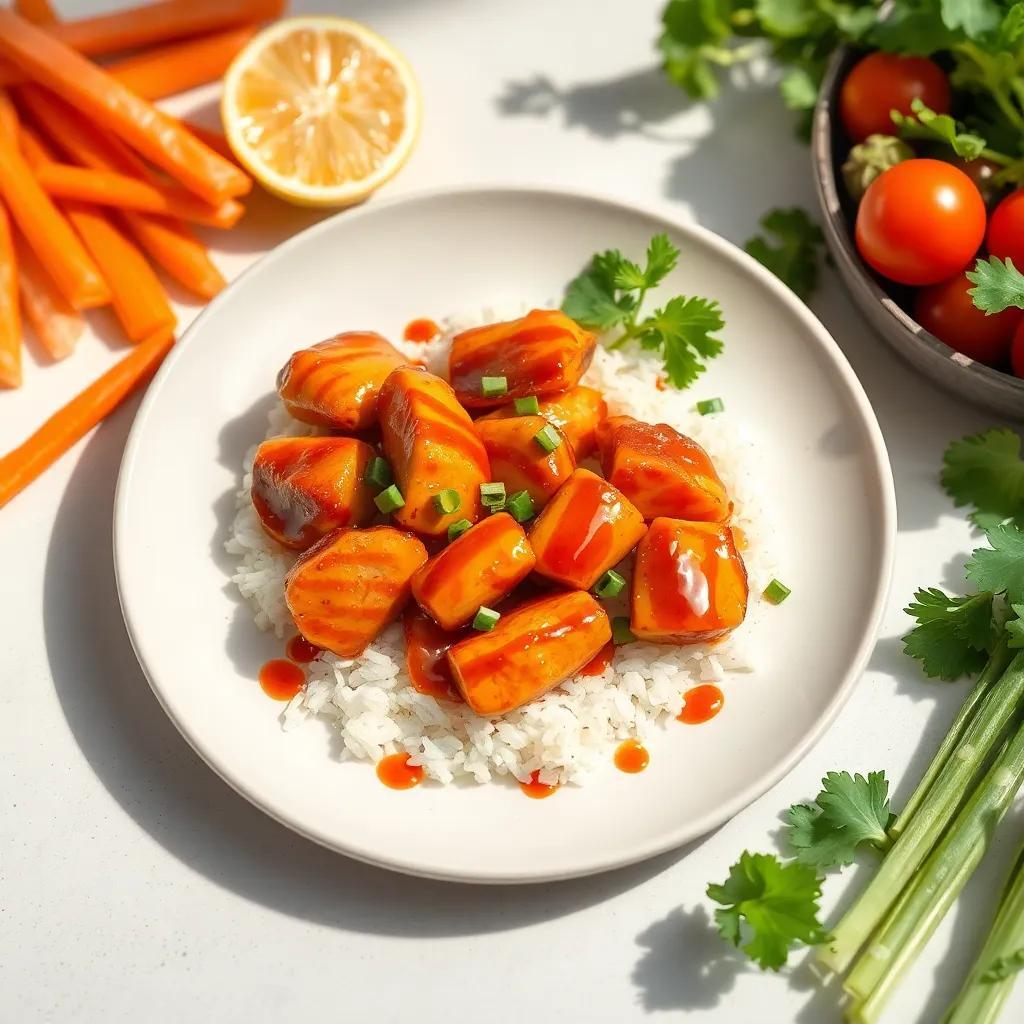Unlock Ultimate Comfort: Easy 30-Minute Ramen Recipes for Everyone

Unlock Ultimate Comfort: Easy 30-Minute Ramen Recipes for Everyone
🌍 Cuisine: Japanese
⚙️ Difficulty: Easy
Ingredients
- 4 cups chicken broth
- 2 packs instant ramen noodles (discard seasoning packets)
- 2 cloves garlic, minced
- 1 tablespoon soy sauce
- 1 tablespoon miso paste
- 1 teaspoon sesame oil
- 1 cup sliced mushrooms (shiitake or button)
- 2 soft-boiled eggs
- 2 green onions, chopped
- 1 cup baby spinach or bok choy
- 1 teaspoon grated ginger
- Salt and pepper to taste
- Optional: chili flakes or Sriracha for spice
Nutrition Facts
450 kcal
Instructions
- Bring the chicken broth to a simmer in a large pot over medium heat.
- Stir in the minced garlic, grated ginger, soy sauce, miso paste, and sesame oil into the broth. Let it cook for 5 minutes, stirring occasionally.
- Add sliced mushrooms and baby spinach or bok choy to the simmering broth. Let cook for 3–4 minutes until vegetables are tender.
- In a separate pot, cook the ramen noodles according to package instructions (usually 2–3 minutes). Drain and set aside.
- While noodles cook, prepare soft boiled eggs: boil eggs for 6–7 minutes, then place them in ice water. Peel and halve the eggs.
- Season the broth with salt and pepper to taste. Add chili flakes or Sriracha if you prefer some heat.
- Divide the cooked noodles among four bowls.
- Ladle the hot broth, vegetables, and mushrooms over the noodles.
- Top each bowl with a halved soft-boiled egg and chopped green onions.
- Serve immediately and enjoy your comforting ramen!
Serving Suggestions
- Add sliced pork belly or grilled chicken for extra protein.
- Top with nori (seaweed) strips for authentic Japanese flavor.
- Drizzle extra sesame oil or chili oil for added richness.
- Serve with steamed edamame or gyoza on the side.
- Sprinkle toasted sesame seeds over the ramen for crunch.
- Use vegetable broth instead of chicken broth for a vegetarian version.
- Mix in kimchi for a spicy, tangy twist.
Table of Contents

Intro
There’s something undeniably soothing about a warm bowl of ramen—a perfect blend of savory broth, tender noodles, and vibrant toppings that come together in harmony. This collection of easy 30-minute ramen recipes is designed to bring that comfort straight to your kitchen without the fuss or lengthy cooking times often associated with traditional ramen. Whether you’re looking for a quick weeknight dinner, a cozy meal after a long day, or a flavorful dish to share with friends and family, these recipes hit the mark every time.
What makes these ramen recipes truly exciting isn’t just their speed or simplicity, but how easily they adapt to your taste and mood. From mellow, miso-infused broths to a gentle kick of spice, each bowl invites you to customize and savor something uniquely your own. Plus, the balance of fresh vegetables, soft-boiled eggs, and aromatic seasonings means every spoonful is layered with textures and flavors that never get boring.
Ideal for casual dinners, lazy weekends, or anytime you crave that ultimate comfort food, these ramen dishes are approachable yet satisfying. They prove that you don’t need to be a ramen master or spend hours in the kitchen to enjoy a bowl that warms both body and soul. Get ready to unlock your new favorite go-to meal—one that’s as nourishing as it is delicious, and perfectly suited for everyone at your table.
Ingredient Notes
When it comes to unlocking the full comfort potential of these easy ramen recipes, a few key ingredients take center stage—not just as flavors, but as essential building blocks that elevate the entire bowl.
Miso Paste
This fermented soybean paste is a flavor powerhouse, delivering a deep umami richness that transforms a simple broth into something soulful and complex. When shopping, look for traditional varieties like white (shiro) or red (aka) miso; white miso tends to be milder and sweeter, while red packs a stronger, saltier punch. If miso isn’t on hand, a good-quality tahini or a splash of soy sauce can lend some savory depth as a quick alternative, though the characteristic fermented tang will be less pronounced.
Chicken Broth
Serving as the foundation of your ramen, a well-chosen broth creates warmth and body in every slurp. Using a low-sodium, high-quality chicken broth gives you full control over seasoning, ensuring balance and subtlety. For vegetarians or those seeking lighter options, vegetable broth works beautifully too—especially if it’s homemade or enriched with mushrooms and aromatics for added umami.
Instant Ramen Noodles (without seasoning packets)
Instant ramen noodles are a convenient shortcut that cooks in mere minutes, making your meal effortless without sacrificing that comforting chew and texture. When selecting noodles, try to pick those without added flavor packets (since you’re creating your own broth base) and consider fresh or frozen ramen if available—it’s worth a try for silkier noodles that bring a restaurant feel home. If noodles aren’t preferred, soba or udon can stand in nicely, each contributing their own unique bite and regional flair.
Sesame Oil
A teaspoon of toasted sesame oil is a small but mighty addition that imparts a subtle nutty aroma, rounding off the soup’s warmth and adding layers without overwhelming. It’s best added near the end of cooking to preserve its delicate fragrance. If you don’t have sesame oil, a mild vegetable oil with a touch of toasted nuts—like walnut or peanut—can echo some of those toasty notes in a pinch.
Understanding these ingredients and their roles not only helps when gathering your shopping list but also opens the door to personalizing your ramen experience. Whether you’re experimenting with different broths or swapping in fresh noodles, these staples anchor the recipe, ensuring every bowl feels like a comforting hug.
Tips & Variations
Mastering the art of quick, comforting ramen starts with a few smart strategies and creative twists. To make the most of this 30-minute recipe, consider these tips and variations that cater to different tastes, dietary needs, and pantry setups.
Pro Tips to Elevate Your Ramen Experience:
- Layer your flavors: Build depth by sautéing your garlic, ginger, and mushrooms before adding them to the broth. This step unlocks richer umami tones and gives your soup a more complex aroma, even in a hurried prep.
- Control your salt: Since many broths and soy sauces can be high in sodium, taste your broth midway and adjust salt gradually. Using low-sodium or homemade broth helps keep saltiness in check.
- Perfect your egg timing: For soft-boiled eggs with jammy yolks, initiate boiling the eggs as water comes to a rolling boil, then start your 6-7 minute timer. Plunging them into ice water immediately after cooking not only stops the process but also makes peeling easier.
- Noodles matter: Rinse freshly cooked ramen noodles briefly under warm water if you don’t plan to serve immediately, preventing them from sticking. For a more authentic chew, avoid overcooking by timing noodles to finish just as your broth is ready.
Customizing for Dietary Preferences and Restrictions:
- Vegan/Vegetarian: Swap chicken broth for a rich vegetable or mushroom broth. Double up on umami by adding dried shiitake mushroom powder or a splash of tamari instead of soy sauce. Replace eggs with tofu cubes baked or lightly pan-fried for texture.
- Gluten-Free: Use gluten-free ramen or substitute with rice noodles or shirataki noodles. Ensure your soy sauce is tamari-based or explicitly gluten-free. Miso paste labeling varies, so check to avoid gluten-containing brands.
- Lower Sodium: Choose low-sodium broth, reduce soy sauce, or replace it with coconut aminos for a milder, naturally sweet alternative. Skip added salt if your broth is pre-seasoned.
Exciting Variations to Explore:
- Protein Boosts: Incorporate thinly sliced pork belly, shredded rotisserie chicken, or seared tofu for heartier bowls. Marinate proteins briefly with soy sauce and mirin for that signature savory glaze.
- Vegetable Variety: Enhance texture and nutrients by adding corn kernels, bean sprouts, thinly sliced carrots, or even roasted sweet potatoes. Leafy greens like kale or Swiss chard can swap in for baby spinach or bok choy without compromising flavor.
- Heat and Spice: Experiment by swirling in chili garlic oil, a dash of gochujang (Korean chili paste), or a sprinkle of shichimi togarashi (Japanese seven-spice blend) for bold, layered spice profiles that warm more than just your taste buds.
- Broth Flair: Stir in a spoonful of peanut butter or tahini for a creamy twist, or add a splash of rice vinegar or yuzu juice just before serving to brighten the whole bowl with tangy freshness.
Real-World Example: Imagine a vegetarian weekday dinner where you swap the chicken broth with a shiitake-packed veggie base, toss in tofu cubes and extra greens, and finish with a drizzle of chili oil. The transformation is effortless but satisfying, keeping prep fast while delivering flavor and comfort.
By embracing these tips and variations, you’ll keep every bowl of ramen feeling fresh and suited to your personal craving—whether you want it hearty, light, spicy, or soothing. This flexibility is part of what makes ramen such an enduring comfort food for all seasons and appetites.
Leftovers & Storage
Leftover ramen is a cozy treasure that deserves thoughtful storage to keep its flavors vibrant and textures inviting. Because ramen features both delicate noodles and a rich broth, it’s important to handle leftovers properly to save that satisfying mouthfeel and avoid sogginess.
For best results, store the broth and solid ingredients separately from the noodles if possible. This helps prevent the noodles from soaking up too much liquid and turning mushy. Transfer the broth, mushrooms, greens, and seasonings into an airtight container, and place cooked noodles in a separate container or zip-top bag. Keep soft-boiled eggs peeled and stored in their own small container if you plan to save them, as they maintain their texture better this way.
Refrigerated leftovers are best enjoyed within 2 to 3 days. Make sure your fridge is set to 40°F (4°C) or below to maintain freshness. When ready to eat, gently reheat the broth on the stove until simmering, then add the noodles just to warm through—this helps preserve the springiness of the noodles. Reheat eggs separately or enjoy them cold on top.
If you want to extend the shelf life, the broth and vegetables freeze well for up to 1 month. Freeze them in a freezer-safe container, leaving room for expansion. Avoid freezing the noodles and eggs, as thawing can alter their texture unfavorably. When thawing frozen broth, do so overnight in the fridge before reheating gently on the stove.
This approach also makes meal prepping and packing leftovers for work or school a breeze. Store components in separate containers or multi-compartment lunch boxes, and reassemble just before eating. Adding fresh green onions or a drizzle of sesame oil after reheating can revive those freshly made flavors.
Ultimately, thoughtful storage and reheating unlock the magic of your ramen leftovers, turning them into a convenient yet comforting meal that feels just as rewarding as when freshly made.
Behind the Recipe
Ramen, as we enjoy it today, is much more than just a bowl of noodles—it’s a story steeped in history, culture, and the universal search for comfort in food. Originating from Chinese wheat noodles introduced to Japan in the early 20th century, ramen evolved rapidly post-World War II into a beloved staple that reflects regional tastes and creativity across Japan. This particular easy 30-minute recipe pays homage to traditional elements—like miso and soft-boiled eggs—while embracing the modern need for speed and simplicity.
The recipe captures the essence of ramen’s spirit: a rich, savory broth balanced by tender noodles and fresh vegetables, designed to be accessible without sacrificing soulfulness. Many ramen dishes require hours of simmering and complex seasoning, but the inspiration here was to unlock that same warmth and satisfaction in a fraction of the time—perfect for busy weeknights or anyone craving cozy nourishment without the wait.
On a personal note, this recipe was born from the challenge of wanting authentic flavors in a hurry. Drawing from memories of bustling Tokyo ramen shops and the fragrant kitchen aromas of home cooking, it blends approachable ingredients like instant noodles and store-bought broth with just enough technique—think soft-boiled eggs and a touch of miso—to elevate everyday ingredients into something special. It’s a reminder that comfort food needn’t be complicated, just thoughtfully prepared.
Ultimately, this ramen invites everyone to create their own comforting moment, connecting the past with the present, and the familiar with possibility—all in a bowl ready in 30 minutes. Whether you’re new to ramen or a longtime fan, it’s a small culinary story of how tradition and simplicity can coexist deliciously in your own kitchen.
FAQ
Can I use tofu instead of chicken or pork in these ramen recipes?
How can I make the broth healthier without losing flavor?
What’s the best way to store leftovers, and can I freeze ramen?
Can I prepare any part of the ramen in advance to save time?
Are there easy ways to customize these ramen recipes for gluten-free diets?
How can I spice up my ramen if I like it a bit hotter?
Final Thoughts
There’s something truly comforting about a bowl of ramen that’s both quick to make and satisfying to savor. These easy 30-minute recipes invite you to unlock ultimate comfort without the fuss—perfect for busy days or whenever you crave a cozy, flavorful meal. Whether you stick to the classic or add your own creative spin, ramen’s versatility makes it a delicious adventure every time.
We’d love to hear how your ramen turned out! Feel free to leave a comment, rate the recipe, or share your unique twists with fellow readers. Here’s to many more warm bowls and happy moments in your kitchen!












